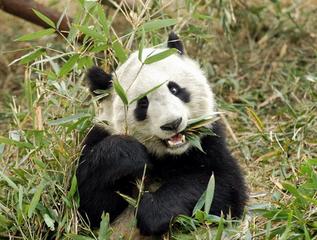Giant Panda
Ailuropoda melanoleuca
The Giant Panda has roamed the Earth for thousands of years. It has roamed over many thousands of miles, but is now down to only six spots on Earth where it lives naturally in the wild. Even though there are a fair amount of the species left, they might be gone before we know it. The Giant Panda has earned a great respect from the Chinese culture, and is a very popular animal to most children because of its cute personality. The following information is intended to give more information on the specifics of the Giant Panda Bear. Enjoy!
Photo: David Blank

Domain: Eukarya (Eukaryote)
Kingdom: Animalia (Animal, multicellular organism that is a heterotroph)
Phylum: Chordata (Has dorsal, hollow nerve cord)
Class: Mammalia (Mammal, feed young with milk from mammary glands)
Order: Carnivora (Have large canine teeth, shearing molars, and well developed claws)
Family: Ursidae (Bear, large mammal)
Genus: Ailuropoda (The Giant Panda)
Species: A. melanoleuca (Black and White Cat-foot)
Picture: Rachael Barger
The Giant Panda is in the Order Carnivora from the Class Mammalia. It is closely related to most every type of bear, but its closest relative is the Spectacled Bear (Tremarctos). It is also very closely related to raccoons (Procyonidae). The Giant Panda originated from the Caniformia or canine part of Carnivora. It is called cat-foot, but isn't as closely related to cats as it is canines.
Any comments or questions? Contact Me
Created by Rachael Barger. April 2007